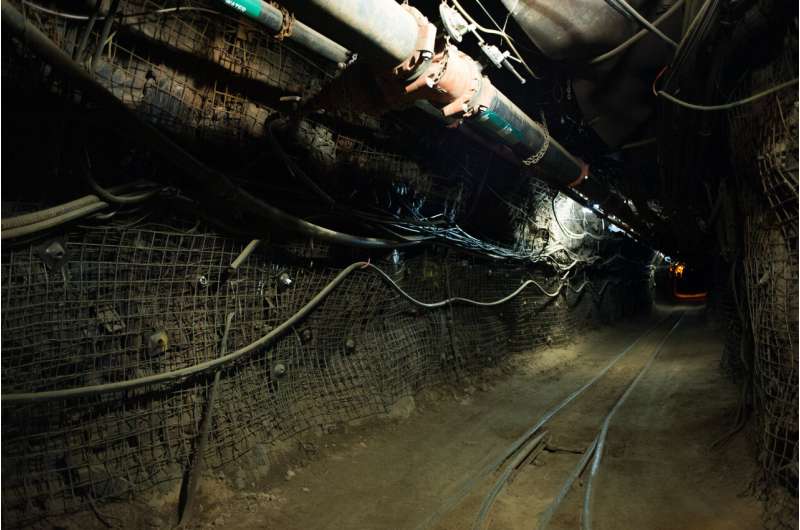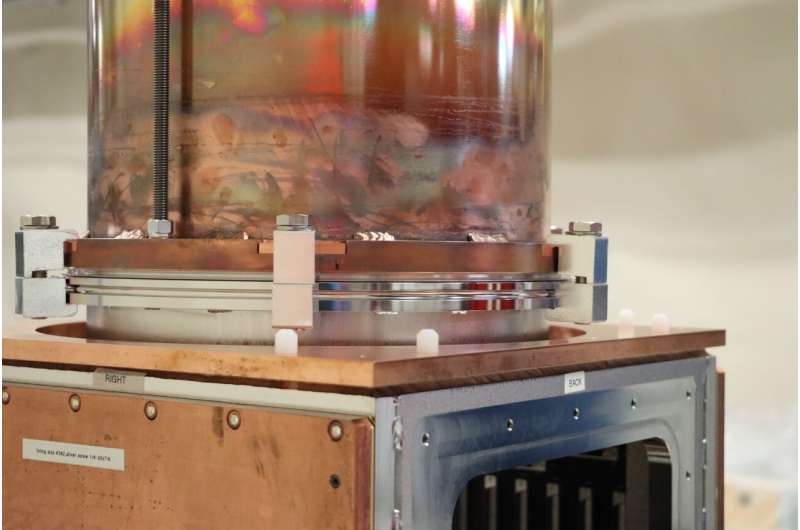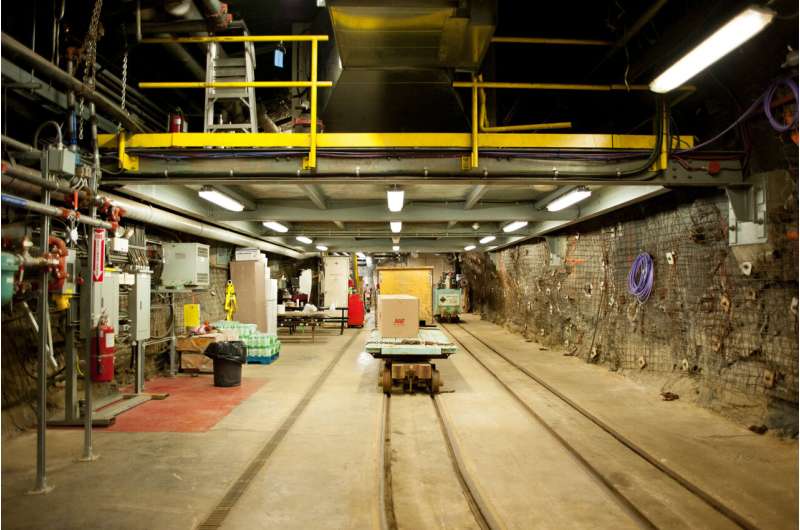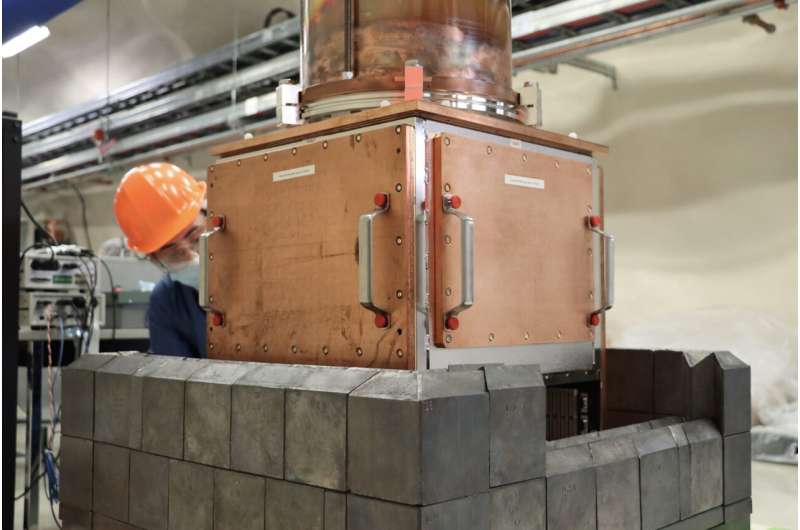Building a cross-border dark matter experiment deep underground, during a pandemic

In the search for dark matter particles, a tabletop experiment in the heart of a Canadian mine might do the trick. The SENSEI collaboration uses skipper charged-couple devices, or CCDs, which are the most sensitive sensors of their kind, dreamt up decades ago and only recently realized.
The collaboration recently proved that the experiment has a sensitive dark matter detector and that it can reduce background rates in an underground experimental area at the Department of Energy's Fermilab. Now, the collaboration is running a bigger, exponentially quieter, more sensitive version of the experiment more than a mile underground at SNOLAB in Canada.
With the COVID-19 pandemic and the closure of the U.S.-Canada border, the experiment could have easily fallen behind schedule in 2020. Instead, it's in its commissioning phase—testing with about 20% of the target material the experiment will use when the outer layers of shielding are in place. Extraordinary teamwork between physicists on both sides of the border ensured that it moved forward on schedule.
Staying safe while progressing science
As the pandemic settled in for its third or fourth month, it dawned on Javier Tiffenberg, associate scientist at Fermilab and SENSEI collaborator, that the Fermilab team's planned experimental installation, slated to begin in 2020, needed rethinking.
Without a way to get to the site, the SENSEI team reached out to SNOLAB to see if staff were open to installing the hyper-sensitive experiment themselves with remote guidance from Fermilab. SNOLAB staff are already familiar with the unique challenges of installing experiments in a clean lab located in a working mine. This time, they'd be performing a weeks-long installation for an experiment they weren't originally going to be a part of.
SNOLAB was game.
"We will be their hands since they can't be here," Silvia Scorza, research scientist at SNOLAB, said of the perspective adopted for the project. She's one of the SNOLAB employees who've taken on helping install projects remotely during the pandemic.

"When the people at SNOLAB said they were interested in contributing to this and then from our side the engineers and technicians said, "Yeah, we can do this," I was super excited because I really thought that this was coming together," Tiffenberg said.
Greg Derylo, an engineer in the Particle Physics Division at Fermilab, designed the layout of SENSEI, worked with the drafting group to make drawings of all the mechanical parts, and procured parts from on- and off-site machine shops. Because of COVID-19 restrictions' effects on access to Fermilab's campus, he also did most of the physical assembly of the experiment.
Derylo said disassembling at Fermilab and re-assembling at SNOLAB was always part of the plan. But remote installation presented a new issue.
"The real trick comes in terms of who is doing that assembly underground," he said. The main concern was handling the fragile (and expensive) skipper CCDs, which are "very susceptible to electrostatic damage." Less than what a person can feel in their hand after rubbing their feet on carpet and touching a doorknob could wreck the sensors. So, the SNOLAB physicists and technicians took a special class in electronics handling.
Testing, testing, and a very pandemic-style party
Before the experiment could be put in SNOLAB's hands, it had to be tested and documented.
"We tested everything at Fermilab. We assembled everything in the same way as they would do it there," Derylo said.
The first test was mechanical—putting together the outside shell of the experiment to confirm it would hold vacuum—and a thermal performance test. SENSEI relies on cryogenics to "run cold." To do this, the Fermilab team put on extra instrumentation to monitor temperatures and run diagnostics. Both performed as expected.
In early fall 2020, the Fermilab team installed a set of test modules into the experiment, turned it on, cooled it down, ran it cold, and operated the modules. The readout went off without a hitch. The team celebrated—each member from their own location via Zoom—with champagne.

Documentation and hand-modeling
Usually, the documentation is more a series of reminders than detailed instructions, and team members can intuit the process or rely largely on memory.
Creating instructions for a team unfamiliar with the experiment required next-level communication. That mostly meant creating documentation with way more detail.
Because the team knew the installation would be remote, they took advantage of their own assembly during testing.
"We took pictures of everything," Tiffenberg said. "Having that documentation was critical."
But coming up with it wasn't without challenges. With multiple people documenting at different times due to the pandemic, communication within the in-group also became more important than usual. Different technicians had different perspectives—literally.
"As it turns out, we actually had opposite definitions of what was the front of the setup," Derylo said. The remedy? SENSEI's newest and one of its most important components: stick-on labels.
The team also built stop points into the documentation. Once a SNOLAB pair reached one of these points, they could determine whether they had time to proceed to the next step in a shift or if they needed clarification from the Fermilab team.

The first draft was ready around the beginning of 2021. Derylo said the documentation was broken into different sections and wound up being around 70 pages. The document is akin to an outline "peppered heavily with photos." Schematics for the vacuum system, the cooler system and electrical cabling were also provided, but weren't part of the booklet.
"Then we took it apart but tried to keep as many pieces together as possible, and then we shipped this to SNOLAB in January," Tiffenberg said.
An ultraclean cleanroom in a working mine
Pandemic issues aside, the process for installing experiments at SNOLAB's underground facility was always complex. After all, it's a clean lab that's located more than a mile underground—inside a working mine.
"Careful planning and preparation start at the surface," Scorza said.
There, at the beginning of the day, physicists, engineers and technicians dressed like miners (plus masks and contact tracing badges for the pandemic) wait for "the cage," a mining elevator to take them deep underground.
The trip down takes less than five minutes. But then there is a journey that's almost a mile through a mine tunnel with a rail track running along it.
"So, watch your step," Scorza said.
Provided by Fermi National Accelerator Laboratory





















